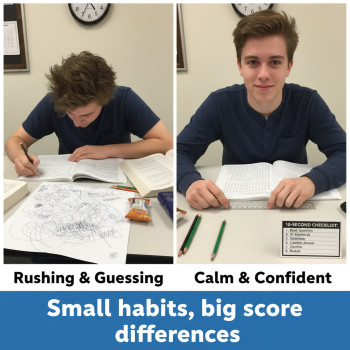Why start SAT prep in 9th grade (and how to avoid burnout)
Starting SAT preparation in 9th grade isn’t about cramming test content early—it’s about building habits, literacy, and confidence at a relaxed pace so that by the time you take real, adaptive Digital SATs in 11th grade you feel powerful, not pressured. Think of it like training for a marathon rather than sprinting a 5K: steady mileage, targeted workouts, and recovery days win races.
Two quick principles to hold onto:
- Consistency beats intensity. Thirty minutes most days will get you farther than five hours one weekend a month.
- Skills first, test mechanics second. Read widely, write clearly, and master the math fundamentals—then layer on test strategy and timing.
Practical note: the College Board provides official digital practice resources (including the Bluebook app and Official SAT Practice on Khan Academy) that mirror the digital experience; use them to calibrate your expectations and practice under real conditions. ([satsuite.collegeboard.org]( a four-year scaffolded roadmap
This plan breaks your prep into four manageable phases—one for each high school year—so you steadily tighten skills without feeling swamped. Each year has a short set of goals, sample weekly rhythms, and milestone checks.
9th grade — exploration and habit-building
Goals: build reading stamina, strengthen foundational algebra and geometry, practice clear paragraph-level writing, and create a low-pressure test routine.
- Reading: aim for one sustained, varied reading session per day (news feature, short nonfiction essay, classic short story, science article).
- Math: master pre-algebra and basic algebra topics; focus on number sense, linear equations, ratios, percent, and basic geometry proofs/logic.
- Writing: practice paragraph organization, thesis statements, and concise editing.
- Routine: schedule two 30–45 minute weekly sessions of SAT-style practice (sample questions or mini-sections) to become comfortable with question formats.
Why this matters: early exposure reduces test anxiety later and makes advanced strategies (like adaptive-test pacing or digital annotation) second nature. Use digital practice previews and sample questions on official College Board resources to become familiar with the testing app and tools. ([satsuite.collegeboard.org]( grade — skill development and small tests
Goals: deepen knowledge across the main SAT domains, begin full-section practice, and measure progress with a low-pressure School Day or PSAT 10 if available.
- Reading & Writing: practice evidence-based reading—find the sentence or paragraph that justifies each answer. Start practicing timed passages (but keep the time lenient at first).
- Math: refine algebra II topics, functions, systems, and more advanced geometry/trigonometry concepts that appear on higher-level problems.
- Practice tests: take a Bluebook digital test preview and try at least one adaptive practice test to get comfortable with the interface.
- Adjust: identify two target weakness areas and make a three-month micro-plan to address them (e.g., complex sentences or quadratic applications).
Milestone: a diagnostic digital practice test (Bluebook app) to produce a baseline score and skill report. Use that report to set realistic score goals for junior year. ([satsuite.collegeboard.org]( grade — strategic practice and peak testing
Goals: take your best, fully timed, digital SATs during the spring and fall windows; refine strategies, practice full adaptive tests, and prioritize college timeline needs (applications, scholarship deadlines).
- Practice rhythm: 3–4 focused sessions weekly—one full practice test every 4–6 weeks, plus targeted review sessions on missed content.
- Timing strategies: practice digital tools (highlight, strikeout, built-in calculator) and adapt your pacing to section adaptability.
- Test planning: pick target test months that give time for one retake before application deadlines (for most U.S. schools, fall of senior year or earlier).
Note: College Board’s Bluebook app and downloadable practice tests are the official way to experience the digital format and adaptive item behavior—use them for at least some of your full-test practice. ([satsuite.collegeboard.org]( grade — final polishing and application timing
Goals: fine-tune, avoid over-practice, and align final test dates with college deadlines. At this point, you should be maintaining skills, continuing light practice, and addressing any remaining weak points.
- Light maintenance: two short practice sessions a week, or one full practice test every 6–8 weeks, focusing on accuracy and confidence.
- Application alignment: if you’ve reached target scores, avoid unnecessary additional tests unless you expect a clear improvement.
Tip: colleges receive digital SAT scores in a standard format; make sure you understand where and when to send scores based on your application timeline. Official College Board resources explain score reporting and test-day details. ([satsuite.collegeboard.org]( to build your weekly and monthly routines
Consistency is the engine of progress. Below is a flexible sample plan that balances school, extracurriculars, and rest while ensuring steady improvement.
Sample weekly schedule (during a normal school week)
- Monday: 30 minutes reading practice (one long passage + annotations)
- Tuesday: 45 minutes math skills (focus topic, practice problems, error log)
- Wednesday: 30 minutes writing and grammar drills (sentence structure, evidence questions)
- Thursday: 45 minutes targeted practice on weakest area from last full test
- Friday: rest or light review (flashcards, vocabulary)
- Weekend (Saturday): 60–90 minutes—alternate between a timed mini-section or full practice test every 3–4 weeks
- Weekend (Sunday): Review mistakes, update error log, plan next week
Keep an error log that records question type, your mistake, and the correct reasoning. Over time you’ll see patterns and be able to adjust study blocks to target the highest-leverage weaknesses.
Monthly checkpoints
- Month 1: diagnostic test and goal setting
- Month 3: first adaptive practice test (Bluebook) to measure progress
- Month 6: reassess goals; consider a short block of tutoring for stubborn gaps
- Month 12: full practice test under test-day conditions
Practical strategies: reading, writing, and math
Reading that actually helps your score
Read with purpose. For SAT reading, practice locating evidence and understanding an author’s argument and structure. Use these active reading tactics:
- Preview the passage quickly—note tone, structure (cause/effect, compare/contrast), and the likely question types.
- Underline or digitally highlight the thesis and topic sentences.
- When answering, always find the evidence line(s) that support your choice; treat this like a fact-finding mission.
Real-world practice: read one high-quality article a week (The Atlantic, Scientific American, or a reputable news magazine) and summarize the author’s thesis in one sentence. That one-sentence habit trains precision.
Writing and language: clarity over cleverness
For grammar and expression questions, the SAT favors clarity and economy. Practice editing paragraphs to remove redundancy and fix logical flow. Short exercises:
- Replace wordy phrases with concise alternatives.
- Practice combining short sentences to improve flow without adding ambiguity.
- Do quick grammar drills on common areas: subject-verb agreement, modifiers, parallel structure.
Math: build conceptual fluency, not just tricks
The digital SAT still tests algebraic thinking, problem solving, and quantitative reasoning. Prioritize:
- Understanding why an approach works, not just memorizing steps.
- Translating word problems into equations and diagrams.
- Practicing mental math and effective calculator use—know when to estimate and when to compute precisely.
How to use official digital practice effectively
Official practice tools were designed to mirror the adaptive digital test environment. Don’t just take tests—study them:
- Simulate test-day conditions: quiet room, required breaks, and the same device and app if possible.
- After each test, spend twice as much time reviewing mistakes as you spent answering questions—understand the root cause.
- Use the College Board’s digital practice tests and the Bluebook preview to test your comfort with tools like highlighting, strikethrough, and navigation. ([satsuite.collegeboard.org]( to consider personalized tutoring—and how Sparkl fitsTutoring is most effective when it’s targeted. Consider 1-on-1 help if any of these apply:
- You’ve plateaued despite consistent practice.
- You have a limited timeline before applications and need a focused plan.
- You learn best with guided feedback and accountability.
Sparkl’s personalized tutoring can be a natural fit into a long-term roadmap—especially if you want tailored study plans, expert tutors who diagnose root causes, and AI-driven insights that help prioritize topics. Sparkl works well for students who want regular check-ins, customized practice sets, and a coach to help turn practice-test data into an action plan rather than just pages of missed questions.
Sample 18-month intensive block for sophomores and juniors
If you begin more intensive prep in the spring of 10th grade or the summer before 11th, here’s a compact plan to maximize gains without burning out.
Months Focus Weekly Time Milestone 1–3 Baseline diagnostics, core skill rebuild (reading, algebra) 4–6 hours Diagnostic score + skill map 4–9 Targeted content blocks and strategy for weak areas 6–8 hours Consistent +1 to +X score improvement on practice tests 10–15 Full-adaptive practice tests, timing drills, stress management 6–10 hours Two realistic practice test dates with final prep plan 16–18 Final polish, application alignment, light maintenance 3–5 hours Target score or decision to submit/retake Dealing with setbacks and plateaus
Everyone stalls sometimes. When progress halts, try this simple diagnostic routine:
- Check your error log for patterns (timing, question type, careless errors).
- Cut the test time in half and do a deep review of just 10–12 questions to understand thinking errors.
- Switch methods: if you’ve been self-studying, add short targeted tutoring or a focused problem set from an official source.
Remember: plateaus are often where the biggest gains begin. The trick is persistence with a smarter approach, not more of the same.
Balancing SAT prep with school, activities, and mental health
A long-term prep plan should protect sleep, social time, and academic performance. Practical safeguards:
- Never sacrifice less than 7–8 hours of sleep for extra studying—cognition and memory solidify during sleep.
- Keep Sunday evenings tech-light to mentally reset for the week.
- Use practice test windows to schedule rest days afterward; hard practice deserves recovery.
If test anxiety is a recurring issue, consider both mindfulness tools (short breathing practices before tests) and working with a tutor or counselor to practice desensitization—mock testing under realistic conditions reduces anxiety significantly over time.
Concrete checklists and tools
Use this quick checklist at the start of each school year to align your roadmap:
- Set a target SAT score aligned to your college list or scholarship goals.
- Take an official digital diagnostic test (Bluebook) and save the report.
- Create a weekly schedule that includes at least 2–3 practice blocks and a monthly full practice test.
- Maintain an error log and review it for recurring themes every two weeks.
- Decide on tutoring cadence if needed—monthly check-ins, weekly sessions, or project-based sprints.
Real-world example: Emily’s four-year journey
Emily started ninth grade nervous about math and indifferent to nonfiction reading. Her roadmap looked like this:
- 9th grade: daily 20–30 minute reading practice and twice-weekly math drills. Result: improved class performance and reading stamina.
- 10th grade: diagnostic test + a 12-week algebra refresh. Took a PSAT 10 in spring to get used to the digital platform.
- 11th grade: launched an 8-month intensive block with weekly 1-on-1 tutoring focused on problem-solving and timed practice; used official Bluebook adaptive tests every 6 weeks. Result: a steady climb to Emily’s target score.
- 12th grade: one final practice test and a light maintenance schedule; she applied to her target schools confident in her score choices.
Emily used a mix of self-study, school resources, and occasional Sparkl sessions for focused diagnostics and strategy—an approach that let her keep extracurricular leadership and social life while improving her score substantially.
Common myths and the reality
- Myth: “You must spend 100+ hours in one summer to get a great score.” Reality: Spread practice over years is more sustainable and often more effective.
- Myth: “Only tutors can raise your score.” Reality: Many students make big gains with deliberate, disciplined self-study; tutoring accelerates and clarifies progress when used strategically.
- Myth: “Digital format means everything changed.” Reality: Core skills—reading comprehension, clear writing, and math reasoning—still matter most; the digital format mainly affects navigation and tool use. Official digital practice is the best way to adapt to the format. ([satsuite.collegeboard.org]( tips: what high schoolers should remember
- Start early but stay patient—small, sustained improvements compound.
- Use official digital tests to calibrate your practice and keep a running skill map.
- Practice under realistic conditions to reduce test-day surprises.
- Consider targeted tutoring (like Sparkl’s personalized tutoring) when plateaus or timelines demand outside expertise—used well, it becomes the most efficient way to close stubborn skill gaps.
- Keep college goals in view, but don’t let the SAT crowd out meaningful, joyful learning—read things you care about and pursue projects that reflect you.

Parting encouragement
Mapping out a long-term Digital SAT plan from 9th grade is an investment in skills that outlive one test: clearer writing, stronger reasoning, and focused study habits. Treat the roadmap as a flexible plan, not an ironclad rule. Celebrate small wins—each corrected mistake and every sustained study week is progress toward your goals. With steady practice, smart use of official digital resources, and targeted support when needed, you’ll approach test day not with dread but with quiet confidence.
If you want help turning this roadmap into a personalized year-by-year plan—complete with weekly calendars, targeted practice sets, and periodic check-ins—consider pairing self-study with occasional Sparkl sessions for tailored guidance and data-driven insights that make every study hour count.
Ready to start?
Pick one small action today: take a 30-minute diagnostic on the Bluebook app, start a one-week reading streak, or create your error log template. One small step now builds the momentum that carries you through four years. Good luck—and enjoy getting better, bit by bit.















No Comments
Leave a comment Cancel